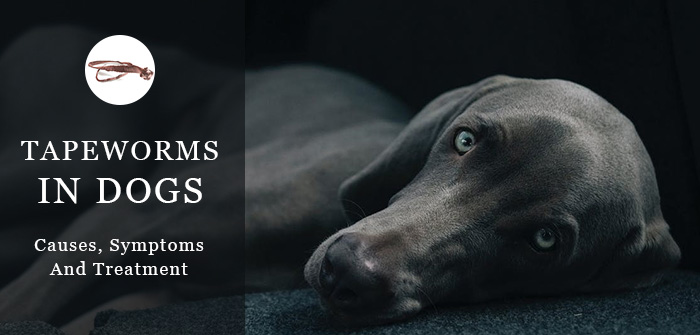Tapeworms In Dogs: Causes, Symptoms And Treatment
Just like roundworms, hookworms and whipworms, tapeworms are also intestinal worms. They have a flat segmented body which is usually 8 inches long. Tapeworms use hoo k-like structure i.e. their head to tether themselves to the intestinal linings of the dog’s body. As the immature tapeworms extract nutrients from the intestines, the segments start increasing in number and form a tail-like structure. These segments are known as proglottids and appear like rice grains. Often these proglottids are seen in the poop of a dog or around his anus which dries up and spread the eggs in the environment. Dipylidium caninum is the most common tapeworm species that infect dogs, cats and humans. Other tapeworm species which could be involved in spreading the infection are Taenia, Echinococcus and Mesocestoides.
k-like structure i.e. their head to tether themselves to the intestinal linings of the dog’s body. As the immature tapeworms extract nutrients from the intestines, the segments start increasing in number and form a tail-like structure. These segments are known as proglottids and appear like rice grains. Often these proglottids are seen in the poop of a dog or around his anus which dries up and spread the eggs in the environment. Dipylidium caninum is the most common tapeworm species that infect dogs, cats and humans. Other tapeworm species which could be involved in spreading the infection are Taenia, Echinococcus and Mesocestoides.
What Causes Tapeworms In Dogs?
Tapeworms require an intermediate host, usually a flea, before it could infect dogs. When the flea sits on the contaminated fecal matter of other animals, it picks up the tapeworm eggs which transform into larva inside the flea’s body. When a dog ingests this infected flea either while biting or grooming himself or grooming other animals, it in turn contracts the tapeworm. This larval stage matures into an adult tapeworm. This adult tapeworm sheds its segment off and on which could be then seen in the stools or near the anus of the dog.
Dogs living in the rural or suburban area are at greater risk of contacting these worms because of more population of fleas in the woody regions.
How To Detect Tapeworms In Dogs?
Keep an eye on your dog’s poop. Fresh fecal matter usually contains proglottids i.e. white grain-like structures which is a tell-tale sign of tapeworm infection in dogs. These segments can also be found stuck to the fur of the anal region of the infected dog. Other symptoms of tapeworm infection in dogs are :
- excessive scooting due to itching in the hind region
- irritability
- biting the anus
- anemia
- weight loss
- weakness
- diarrhea
- vomiting or nausea
Sometimes dogs can even vomit the tapeworms but that is less frequent.
How Are Tapeworms Diagnosed In Dogs?
All of the symptoms related to tapeworm infection are indicative of the infestation. Sometimes stools tests may not give a positive result even if the dog has tapeworms because they may or may not have shed when the dog pooped. So, basically, it is left up to a pet owners discretion whether he is sure about the infection or not.
How To Treat Tapeworms In Dogs?
Treatment drugs that contain praziquantel as an active ingredient are very beneficial in treating tapeworm infection in dogs. Some combination drugs like Drontal All wormer Dog, Endogard and Popantel For Dogs are also very effective in treating other worm infections like hookworms, whipworms and roundworms along with tapeworms.
Can Tapeworms Infect Humans?
Probably you don’t know but humans can also get tapeworm infection if they aren’t careful. Touching any contaminated matter or ingestion of fleas, consuming contaminated veggies can cause severe tapeworm infection in humans. So, wash your hands and wash your vegetables thoroughly to eliminate all the chances of contracting tapeworm infection.
Can Tapeworms Be Prevented?
Yes, they can be prevented by keeping the dog on flea-preventatives throughout the year. Also, you should groom your dog thoroughly and maintain a weekly routine for doing so. Clean his paws immediately after he gets back from an outing. Keep him away from garbage and trash bins. Do not allow him to go near dead animals. Most importantly, pay regular visits to the vet and inform if immediately if you find any signs of tapeworm infection in your pet.
Though tapeworm infection can be successfully treated with medicines, it is extremely necessary to start providing him preventatives as the infection can recur if flea population is high in your region.

